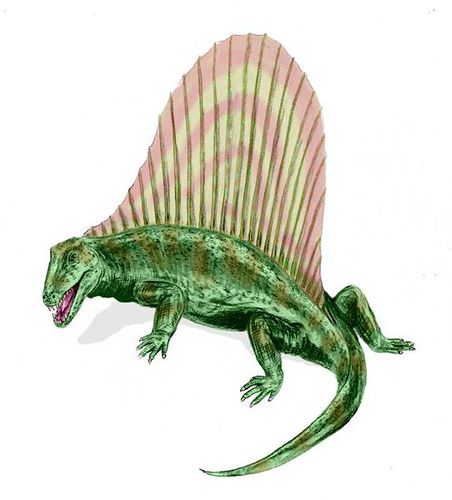12.31 哺乳动物祖先
章节大纲
-
Which mammalian trait evolved first? What was the first mammal like? When did the earliest mammal live?
::第一个哺乳动物是什么样子?最早的哺乳动物是什么时候存活的?Detailed answers to these questions are still in dispute, though it is probably safe to say the earliest mammals were not like this giraffe. Obviously, the giraffe has some specialized traits.
::这些问题的详细答案仍然有争议,尽管可以说最早的哺乳动物不像长颈鹿。 显然,长颈鹿有一些特殊的特征。Major Events in Mammalian Evolution
::哺乳动物进化中的主要活动Scientists do generally agree on the major events in the evolution of mammals. These are summarized in Table . Refer back to the table as you read about the events in this concept. *mya = millions of years ago
::科学家们对哺乳动物进化过程中的主要事件一般意见一致,这些摘要见表。您读到关于这个概念中的事件时,请回到表格中。 *mya=数以百万计年前。Era Period Epoch Major Events Start (mya)* Cenozoic Neogene Holocene Rise of human civilization; spread and dominance of modern humans 0.01 - - Pleistocene Spread and then extinction of many large mammals; appearance of modern humans 1.8 - - Pliocene Appearance of many existing genera of mammals, including the genus Homo 5.3 - - Miocene Appearance of remaining modern mammal families; diversification of horses and mastodons; first apes 23.0 - Paleogene Oligocene Rapid evolution and diversification of 33.9 - - Eocene Appearance of several modern mammal families; diversification of primitive whales 55.8 - - Paleocene Appearance of the first large mammals 65.5 Mesozoic Cretaceous - Emergence of , , and placental mammals; possible first appearance of four clades (superorders) of placental mammals (Afrotheria, Xenarthra, Laurasiatheria, Supraprimates) 145.5 - Jurassic - Spread of mammals, which remain small in size 199.6 - Triassic - Evolution of cynodonts to become smaller and more mammal-like; appearance of the first mammals 251.0 Paleozoic Permian - Evolution and spread of synapsids ( pelycosaurs and therapsids) 299.0 - Carboniferous - Appearance of amniotes , the first fully vertebrates 359.0 Mammalian Ancestors
::Mammalian 祖先传教士Ancestors of mammals evolved close to 300 million years ago. They were amniotes called synapsids . Figure shows how modern mammals evolved from synapsids. The stages of evolution from synapsids to mammals are described below.
::哺乳动物的祖先在近3亿年前就进化了,它们是被称为突触的羊膜。图表显示了现代哺乳动物如何从突触进化。下面将描述从突触到哺乳动物的进化阶段。Phylogeny of Mammalian Evolution. This diagram represents the evolution of mammals.
::哺乳动物进化的金银色。本图代表哺乳动物的进化。Pelycosaurs
::栖息动物Synapsids called pelycosaurs became the most common land vertebrates during the first half of the Permian Period. A pelycosaur genus called Dimetrodon is shown in Figure . Dimetrodon had sprawling legs and walked like a lizard. It also had a fairly small brain . However, it had started to develop some of the traits of mammals. For example, it had teeth of different types.
::被称为“颗粒龙”的合成物在Permian时期前半期成为最常见的陆地脊椎动物。图中显示的是称为Dimetrodon的雌性动物基因。Dimetrodon像蜥蜴一样伸展了双腿和行走。它也有一个相当小的大脑。然而,它开始开发哺乳动物的一些特性。例如,它有不同种类的牙齿。Pelycosaur Synapsid: Dimetrodon . Dimetrodon was a pelycosaur. It lived about 275 million years ago.
::Dimetrodon是一只食肉动物,大约在2.75亿年前存活。Therapsids
::病原体Some pelycosaurs gave rise to a group of called therapsids . The earliest therapsids lived about 260 million years ago. At first, the therapsids looked a lot like Dimetrodon . But after a while, they could easily be mistaken for mammals. They evolved a number of mammalian traits, such as legs positioned under the body instead of along the sides. Therapsids became the most common and diverse land vertebrates during the second half of the Permian Period.
::某些食虫动物产生了一组叫做“草原”的动物。最早的草原在2.6亿年前就已存在。起初,草原看起来与迪米特罗登(Dimetrodon)非常相似。但经过一段时间后,它们很容易被误认为哺乳动物。它们演变出许多哺乳动物的特性,比如在身体下面而不是两侧的腿。在珀米亚时期后半期,草原成为最常见的、最多样化的陆生脊椎动物。The Permian Period ended about 250 million years ago with a . Most therapsids went extinct. Their niches were taken over by sauropsids . These were the amniotes that evolved into dinosaurs , , and . Not all therapsids went extinct, however. The few that remained no longer had to compete with many other therapsids. Some of them eventually evolved into mammals.
::波尔米亚时期在大约2.5亿年前结束。大多数的草原灭绝了。它们的位置被沙罗皮斯占据了。这些是进化成恐龙的羊膜, 和。然而,并非所有的草原都灭绝了。剩下的少数已经不再与许多其他的草原竞争了。其中一些最终演变成哺乳动物。Cynodonts
::阴道The surviving therapsids were small animals. Some of the most successful were the cynodonts (see Figure ). They flourished worldwide during the first half of the Triassic Period. Some of them ate and were nocturnal , or active at night. Being nocturnal may have helped save them from extinction. Why? A nocturnal niche was one of the few niches that dinosaurs did not take over in the Triassic Period.
::幸存的草原是小动物。 最成功的是细胞激素(见图 ) 。 在三亚西克时期的前半期,它们在世界各地蓬勃发展。 其中一些在夜里吃过饭,在夜里或晚上活动。 夜间活动或许有助于它们免于灭绝。 为什么? 夜里活动是恐龙在三亚西克时期没有接管的少数地方之一。Cynodonts became more mammal-like as they continued to evolve. Some of their mammalian traits may have been adaptations to their nocturnal niche. For example:
::随着哺乳动物的不断演化,这些哺乳动物变得更加像哺乳动物。它们的一些哺乳动物特征可能是适应了它们夜间的位置。例如:-
The ability to regulate body temperature might have been selected for because it would allow nocturnal animals to remain active in the cool of the night.
::之所以选择调节体温的能力,可能是因为这样可以让夜间动物在夜凉中继续活动。 -
A good sense of
hearing
might have been selected for because it would be more useful than good
when hunting in the dark.
::可能选择了一种良好的听力感,因为它在黑暗中打猎时比打猎更有用。
Probable Mammalian Ancestor: Cynodont. Cynodonts were mammal-like therapsids. They may have been ancestral to mammals. They were about the size of a rat.
::可能是哺乳动物的祖先,它们与老鼠差不多大。By the end of the Triassic Period, cynodonts had become even smaller in size. They also had evolved many mammalian traits. For example, they had
::到三亚纪时期结束时,细胞激素的体积已经变得更小,它们也发展了许多哺乳动物的特性,例如,它们已经发展了许多哺乳动物的特性。-
Four different types of teeth
::四种不同类型的牙牙牙 -
A relatively large brain
::一个相对较大的大脑 -
Three tiny
in the middle ear
::中耳三小个小 -
A
diaphragm
for
::隔膜 -
Lactation
::哺乳时间 -
Hair
::毛发
Cynodonts probably gave rise to mammals about 200 million years ago. However, they are not considered to be mammals themselves. In fact, with early mammals may have led to their extinction. They went extinct sometime during the Jurassic or Cretaceous Period.
::脊椎动物在大约2亿年前可能就产生了哺乳动物,然而,它们本身并不被视为哺乳动物。事实上,早期哺乳动物可能已经灭绝。它们在侏罗纪或白鲸时期的某个时候灭绝了。Summary
::摘要-
Amniotes called synapsids were the ancestors of mammals.
::哺乳动物的祖先是突触动物 -
Synapsids named pelycosaurs had some of the traits of mammals by 275 million years ago.
::以食肉动物命名的合成物在2.75亿年前 具有哺乳动物的一些特性。 -
Some synapsids evolved into therapsids, which became widespread during the Permian Period.
::有些突触演变成减速,在百年时期广泛流行。 -
The few therapsids that survived the Triassic takeover were small, arboreal insect eaters. They were also nocturnal. Being active at night may explain why they survived and evolved still more mammalian traits.
::Triassic接管案的少数幸存的草原是小的、正方形的昆虫食虫者。它们也是夜行的。 夜间活动可以解释为什么它们生存下来并进化出更多的哺乳动物特征。
Review
::回顾-
What were the synapsids? When were they most widespread?
::那些突触是什么? -
Identify the therapsids. How were they related to mammals?
::识别减速,它们与哺乳动物有什么关系? -
Describe cynodonts. What is their place in the evolution of mammals?
::在哺乳动物的进化过程中,它们的位置是什么? -
Describe mammalian traits found in cynodonts.
::描述在细胞激素中发现的哺乳动物特征。
-
The ability to regulate body temperature might have been selected for because it would allow nocturnal animals to remain active in the cool of the night.



